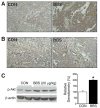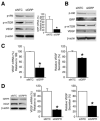Bombesin induces angiogenesis and neuroblastoma growth
- PMID: 17383815
- PMCID: PMC2709810
- DOI: 10.1016/j.canlet.2007.02.007
Bombesin induces angiogenesis and neuroblastoma growth
Abstract
Gastrin-releasing peptide (GRP), the mammalian equivalent of bombesin (BBS), is a trophic factor for highly vascular neuroblastomas; its mechanisms of action in vivo are unknown. We sought to determine the effects of BBS on the growth of neuroblastoma xenografts and on angiogenesis. BBS significantly increased the growth of SK-N-SH and BE(2)-C human neuroblastomas; tumors demonstrated increased expression of angiogenic markers, PECAM-1 and VEGF, as well as phosphorylated (p)-Akt levels. RC-3095, a BBS/GRP antagonist, attenuated BBS-stimulated tumor growth and angiogenesis in vivo. GRP or GRPR silencing significantly inhibited VEGF as well as p-Akt and p-mTOR expression in vitro. Our findings demonstrate that BBS stimulates neuroblastoma growth and the expression of angiogenic markers. Importantly, these findings suggest that novel therapeutic agents, targeting BBS-mediated angiogenesis, may be useful adjuncts in patients with advanced-stage neuroblastomas.
Figures





Similar articles
-
Phosphatidylinositol 3-kinase regulation of gastrin-releasing peptide-induced cell cycle progression in neuroblastoma cells.Biochim Biophys Acta. 2007 Jun;1770(6):927-32. doi: 10.1016/j.bbagen.2007.02.002. Epub 2007 Feb 20. Biochim Biophys Acta. 2007. PMID: 17379415 Free PMC article.
-
Antagonists of bombesin/gastrin-releasing peptide decrease the expression of angiogenic and anti-apoptotic factors in human glioblastoma.Anticancer Drugs. 2005 Feb;16(2):159-65. doi: 10.1097/00001813-200502000-00007. Anticancer Drugs. 2005. PMID: 15655413
-
A gastrin-releasing peptide receptor antagonist stimulates Neuro2a neuroblastoma cell growth: prevention by a histone deacetylase inhibitor.Cell Biol Int. 2009 Aug;33(8):899-903. doi: 10.1016/j.cellbi.2009.04.014. Epub 2009 May 6. Cell Biol Int. 2009. PMID: 19426821
-
Gastrin-releasing peptide as a molecular target for inflammatory diseases: an update.Inflamm Allergy Drug Targets. 2013 Jun;12(3):172-7. doi: 10.2174/1871528111312030003. Inflamm Allergy Drug Targets. 2013. PMID: 23621446 Review.
-
Targeting gastrin releasing peptide receptors: New options for the therapy and diagnosis of cancer.Cell Cycle. 2010 May;9(9):1738-41. doi: 10.4161/cc.9.9.11347. Epub 2010 May 29. Cell Cycle. 2010. PMID: 20473035 Review.
Cited by
-
miR-335 and miR-363 regulation of neuroblastoma tumorigenesis and metastasis.Surgery. 2013 Aug;154(2):226-33. doi: 10.1016/j.surg.2013.04.005. Epub 2013 Jun 24. Surgery. 2013. PMID: 23806264 Free PMC article.
-
Bombesin Receptor Family Activation and CNS/Neural Tumors: Review of Evidence Supporting Possible Role for Novel Targeted Therapy.Front Endocrinol (Lausanne). 2021 Sep 1;12:728088. doi: 10.3389/fendo.2021.728088. eCollection 2021. Front Endocrinol (Lausanne). 2021. PMID: 34539578 Free PMC article. Review.
-
FAK is a critical regulator of neuroblastoma liver metastasis.Oncotarget. 2012 Dec;3(12):1576-87. doi: 10.18632/oncotarget.732. Oncotarget. 2012. PMID: 23211542 Free PMC article.
-
Antioxidant inhibition of steady-state reactive oxygen species and cell growth in neuroblastoma.Surgery. 2015 Sep;158(3):827-36. doi: 10.1016/j.surg.2015.03.062. Epub 2015 Jun 16. Surgery. 2015. PMID: 26088922 Free PMC article.
-
Targeting gastrin-releasing peptide as a new approach to treat aggressive refractory neuroblastomas.Surgery. 2011 Mar;149(3):425-32. doi: 10.1016/j.surg.2010.08.011. Epub 2010 Oct 29. Surgery. 2011. PMID: 21035156 Free PMC article.
References
-
- Brodeur GM. Neuroblastoma: biological insights into a clinical enigma. Nat Rev Cancer. 2003;3:203–216. - PubMed
-
- Maris JM, Matthay KK. Molecular biology of neuroblastoma. J Clin Oncol. 1999;17:2264–2279. - PubMed
-
- Meitar D, Crawford SE, Rademaker AW, Cohn SL. Tumor angiogenesis correlates with metastatic disease, N-myc amplification, and poor outcome in human neuroblastoma. J Clin Oncol. 1996;14:405–414. - PubMed
-
- Fukuzawa M, Sugiura H, Koshinaga T, Ikeda T, Hagiwara N, Sawada T. Expression of vascular endothelial growth factor and its receptor Flk-1 in human neuroblastoma using in situ hybridization. J Pediatr Surg. 2002;37:1747–1750. - PubMed
-
- Ferrara N, Gerber HP, LeCouter J. The biology of VEGF and its receptors. Nat Med. 2003;9:669–676. - PubMed
Publication types
MeSH terms
Substances
Grants and funding
LinkOut - more resources
Full Text Sources
Medical
Miscellaneous

